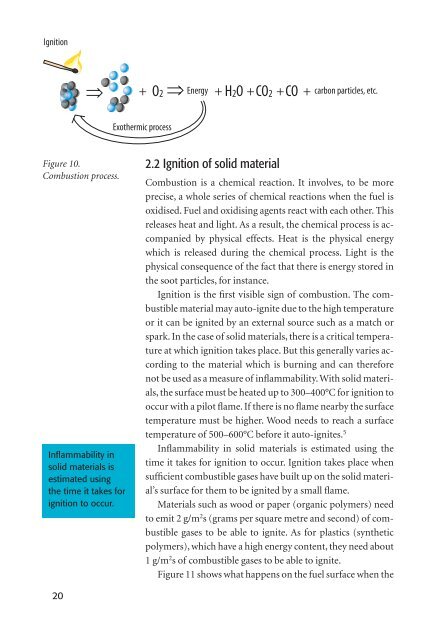Create successful ePaper yourself
Turn your PDF publications into a flip-book with our unique Google optimized e-Paper software.
Ignition<br />
Figure 10.<br />
Combustion process.<br />
Infl ammability in<br />
solid materials is<br />
estimated using<br />
the time it takes for<br />
ignition to occur.<br />
20<br />
+ O2 Energy + H2O + CO2+ CO + carbon particles, etc.<br />
Exothermic process<br />
2.2 Ignition of solid material<br />
Combustion is a chemical reaction. It involves, to be more<br />
precise, a whole series of chemical reactions when the fuel is<br />
oxidised. Fuel and oxidising agents react with each other. This<br />
releases heat and light. As a result, the chemical process is accompanied<br />
by physical effects. Heat is the physical energy<br />
which is released during the chemical process. Light is the<br />
physical consequence of the fact that there is energy stored in<br />
the soot particles, for instance.<br />
Ignition is the fi rst visible sign of combustion. The combustible<br />
material may auto-ignite due to the high temperature<br />
or it can be ignited by an external source such as a match or<br />
spark. In the case of solid materials, there is a critical temperature<br />
at which ignition takes place. But this generally varies according<br />
to the material which is burning and can therefore<br />
not be used as a measure of infl ammability. With solid materials,<br />
the surface must be heated up to 300–400°C for ignition to<br />
occur with a pilot fl ame. If there is no fl ame nearby the surface<br />
temperature must be higher. Wood needs to reach a surface<br />
temperature of 500–600°C before it auto-ignites. 5<br />
Infl ammability in solid materials is estimated using the<br />
time it takes for ignition to occur. Ignition takes place when<br />
suffi cient combustible gases have built up on the solid material’s<br />
surface for them to be ignited by a small fl ame.<br />
Materials such as wood or paper (organic polymers) need<br />
to emit 2 g/m 2 s (grams per square metre and second) of combustible<br />
gases to be able to ignite. As for plastics (synthetic<br />
polymers), which have a high energy content, they need about<br />
1 g/m 2 s of combustible gases to be able to ignite.<br />
Figure 11 shows what happens on the fuel surface when the

















